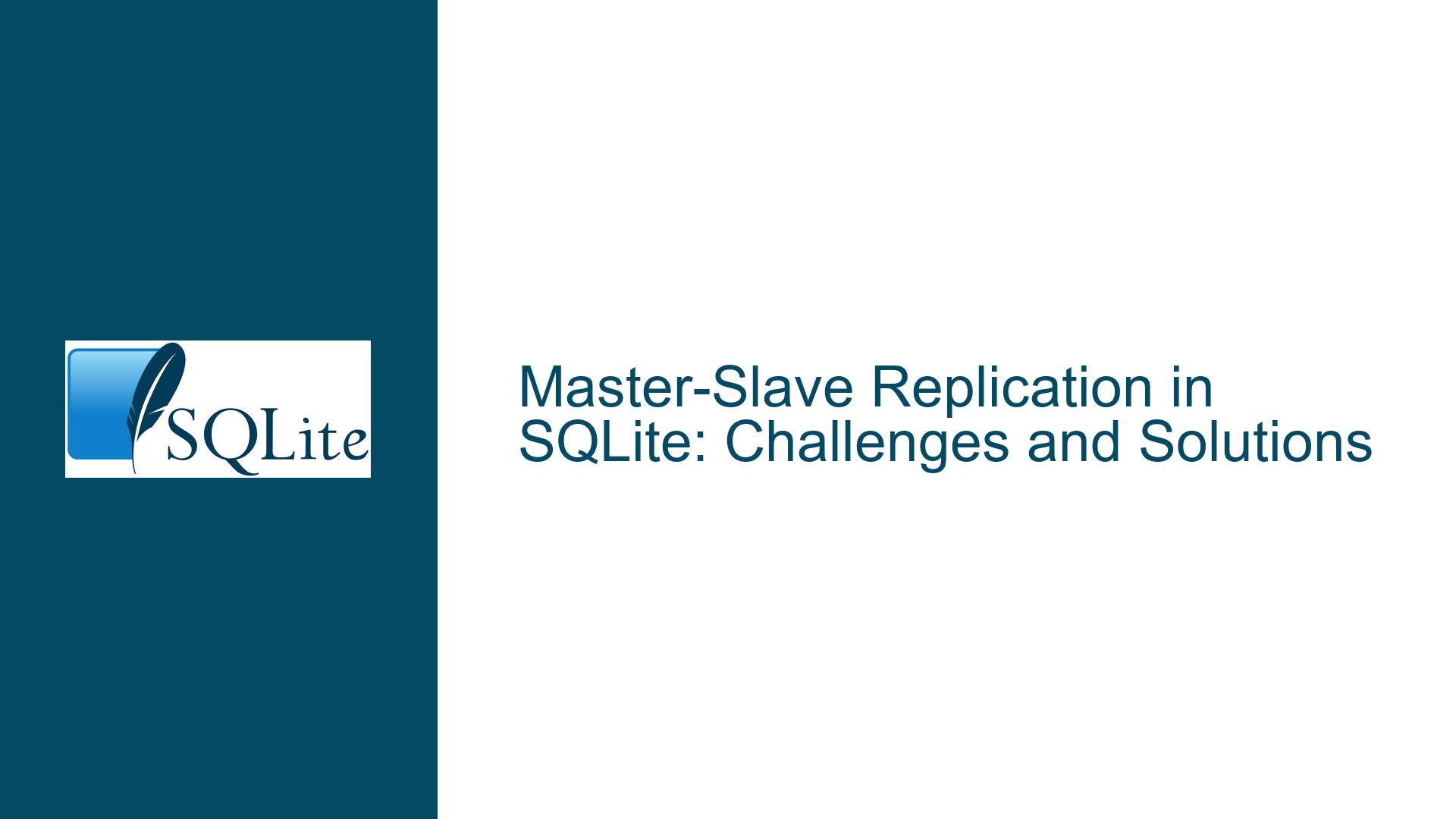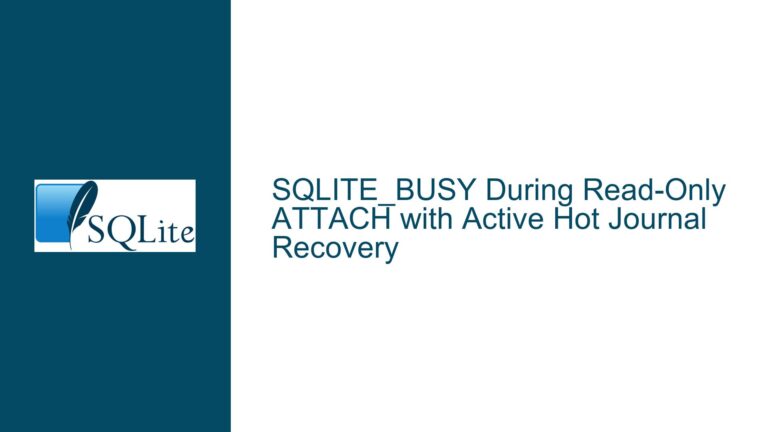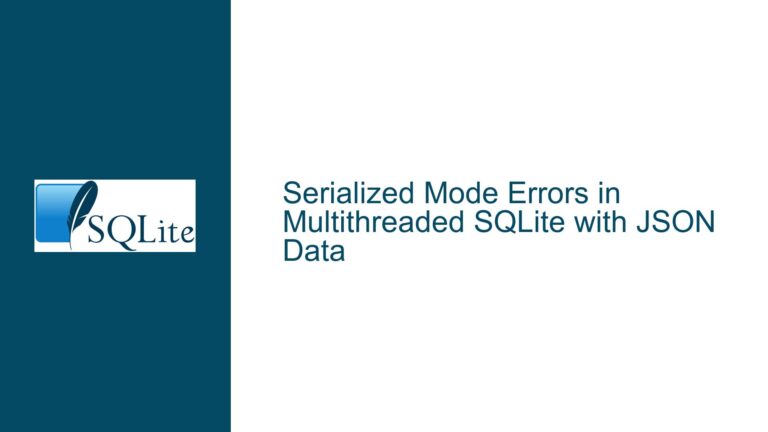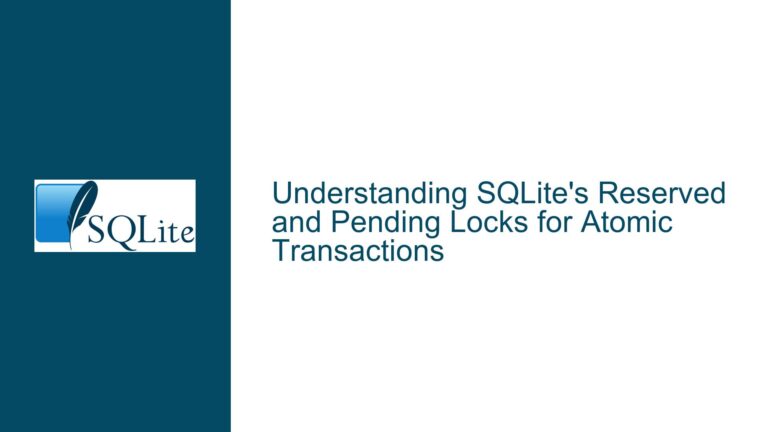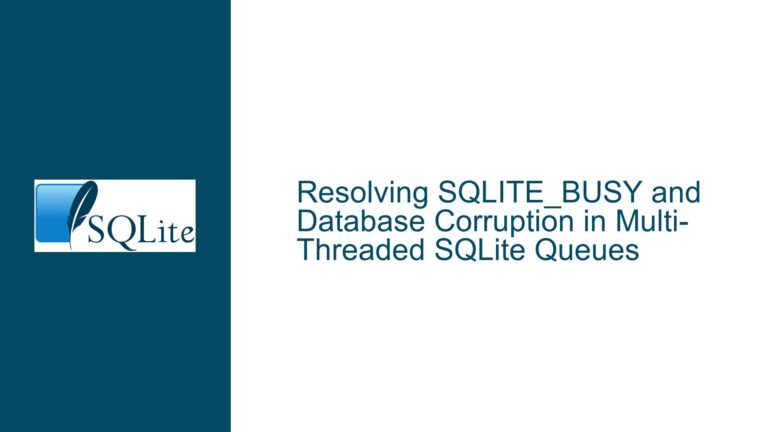Master-Slave Replication in SQLite: Challenges and Solutions
Understanding the Need for Master-Slave Replication in SQLite
SQLite is renowned for its simplicity, speed, and ease of integration, making it a popular choice for embedded database systems. However, one of its limitations is the lack of built-in support for master-slave replication, a feature often required for applications that need high availability, fault tolerance, and data redundancy. Master-slave replication involves maintaining multiple copies of a database across different hosts, where one host (the master) handles all write operations, and the changes are propagated to the other hosts (the slaves). This setup ensures that if the master host crashes, one of the slaves can take over, minimizing downtime and data loss.
The core challenge lies in SQLite’s design philosophy, which prioritizes simplicity and lightweight operation over complex distributed systems features. SQLite is intended to replace fopen() for applications that need a simple, file-based database, not to compete with full-fledged distributed database systems like MySQL or PostgreSQL. As a result, SQLite does not natively support replication, leaving developers to implement custom solutions or rely on third-party tools.
Exploring the Limitations and Trade-offs of Existing Replication Solutions
Several third-party projects have attempted to fill the replication gap for SQLite, each with its own approach and trade-offs. One such project is Litestream, which initially provided replication functionality by tracking changes to SQLite’s Write-Ahead Logging (WAL) files and propagating those changes to slave hosts. However, Litestream’s replication feature was eventually removed, with the project shifting focus to LiteFS, a more complex solution that operates at the filesystem level using FUSE (Filesystem in Userspace). LiteFS monitors block-level changes and replicates them to slave hosts, but this approach introduces additional layers of abstraction, latency, and complexity, as it requires kernel modules and daemons to function.
Another notable project is dqlite, which implements Raft-based replication in C. Dqlite is an active project that offers a more robust replication mechanism, but it comes with the overhead of managing a Raft consensus protocol, which may not be suitable for all use cases. Similarly, rqlite is a Go-based solution that also uses Raft for replication but has limitations, such as the inability to handle transactions or non-deterministic functions. Bedrock is another option, offering a more comprehensive replication solution, but it may be overkill for applications that require a lightweight and simple replication mechanism.
The primary issue with these solutions is that they either rely on abstractions not originally designed for replication (like WAL file tracking) or introduce significant complexity by operating at lower levels of the system (like block-level replication in LiteFS). This complexity can lead to increased latency, higher resource consumption, and a steeper learning curve for developers. Moreover, these solutions often require additional dependencies, such as kernel modules or daemons, which can complicate deployment and maintenance.
Implementing Custom Replication Using SQLite’s Sessions Extension
Given the limitations of existing third-party solutions, developers may consider implementing custom replication mechanisms using SQLite’s built-in features. One such feature is the Sessions Extension, which provides a mechanism for recording changes to SQLite databases. The Sessions Extension works by capturing changes to rowid tables and generating a changeset that can be applied to another database. This changeset can then be serialized and sent to slave hosts, where it is applied to replicate the changes.
The Sessions Extension leverages SQLite’s preupdate hook, a callback mechanism that allows developers to intercept and record changes before they are committed to the database. The preupdate hook provides information about the type of change (insert, update, or delete), the affected row, and the new and old values of the row. This information can be used to construct a changeset that accurately represents the modifications made to the database.
However, there are some limitations to using the Sessions Extension for replication. First, it is primarily designed for rowid tables, and additional steps are required to handle WITHOUT ROWID tables. For WITHOUT ROWID tables, the preupdate callback must explicitly capture the primary key columns, as the rowid is not available. This adds complexity to the replication logic, as the application must ensure that the primary key information is correctly recorded and applied.
Second, the Sessions Extension does not provide a built-in mechanism for transmitting changesets between hosts. Developers must implement their own logic for serializing changesets, sending them over the network, and applying them to slave databases. This requires careful consideration of network latency, error handling, and conflict resolution, especially in scenarios where multiple hosts may attempt to apply changes simultaneously.
Despite these challenges, the Sessions Extension offers a flexible and lightweight way to implement custom replication in SQLite. By leveraging the preupdate hook and changeset generation, developers can build a replication mechanism tailored to their specific requirements, without the overhead and complexity of third-party solutions.
Best Practices for Designing a Custom Replication Solution
When designing a custom replication solution for SQLite, it is essential to consider several best practices to ensure stability, efficiency, and low latency. First, developers should carefully design the changeset format to minimize the amount of data transmitted between hosts. This can be achieved by only including the necessary information in the changeset, such as the type of change, the affected row, and the new values. Additionally, changesets should be compressed before transmission to reduce network overhead.
Second, developers should implement robust error handling and conflict resolution mechanisms. In a distributed system, network failures, host crashes, and conflicting changes are inevitable. The replication system must be able to detect and recover from these issues, ensuring that all hosts eventually converge to a consistent state. This may involve implementing retry logic, conflict detection algorithms, and manual intervention procedures for resolving conflicts.
Third, developers should consider the trade-offs between synchronous and asynchronous replication. Synchronous replication ensures that changes are applied to all hosts before the transaction is committed, providing strong consistency guarantees but potentially increasing latency. Asynchronous replication, on the other hand, allows changes to be applied to slave hosts after the transaction is committed, reducing latency but introducing the risk of data loss in the event of a master host crash. The choice between synchronous and asynchronous replication depends on the specific requirements of the application, such as the acceptable level of data loss and the desired performance characteristics.
Finally, developers should thoroughly test the replication system under various conditions, including network failures, host crashes, and high load scenarios. This testing should include both unit tests for individual components and integration tests for the entire system. By identifying and addressing potential issues during the testing phase, developers can ensure that the replication system is robust and reliable in production environments.
Conclusion: Balancing Simplicity and Complexity in SQLite Replication
In conclusion, while SQLite does not natively support master-slave replication, developers have several options for implementing replication in their applications. Third-party solutions like LiteFS, dqlite, and rqlite offer varying levels of complexity and functionality, but they may introduce additional overhead and dependencies. For developers seeking a more lightweight and customizable solution, SQLite’s Sessions Extension provides a flexible mechanism for capturing and applying changesets, enabling the implementation of custom replication logic.
When designing a replication solution, it is crucial to balance simplicity and complexity, ensuring that the system meets the application’s requirements without introducing unnecessary overhead. By following best practices for changeset design, error handling, and testing, developers can build a robust and efficient replication system that leverages SQLite’s strengths while addressing its limitations. Ultimately, the choice of replication strategy depends on the specific needs of the application, including factors such as performance, consistency, and ease of maintenance.
